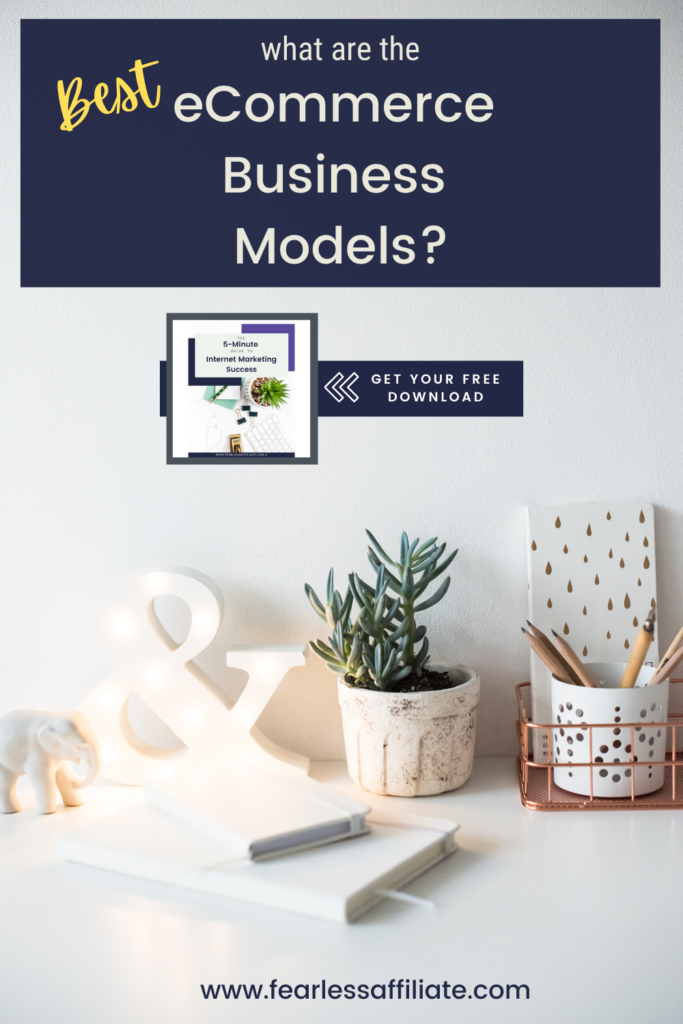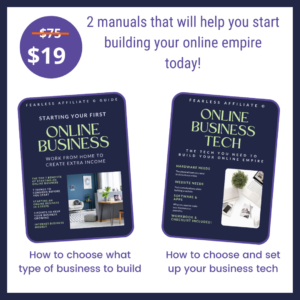We cannot talk about entrepreneurship without talking about what the best ecommerce business models are.
Ecommerce is short for electronic commerce and is also known as internet commerce. Any website you visit that is selling something is an ecommerce business.
Amazon is a huge example of this, but any website that is selling items you may want to buy is an ecommerce website.
Welcome to Fearless Affiliate.
My name is Irma and I help new bloggers to learn the ropes. There is a lot to take in that first year of blogging, from choosing a niche to changing your mindset from worker bee mentality to that of successful entrepreneur.
I like to focus on practical information and positive thinking, so if that sounds good to you please sign up for my weekly newsletter of tips and help for bloggers and online marketers.
Be sure to grab your copy of 5 Minute Guide to Internet Marketing Success guide. Once you have read through this guide, your will have tons of ideas for an online business that will help you earn extra cash or even full-time income!
This post may contain affiliate links. If you click a link and make a purchase, I may receive a commission at no extra cost to you. Full disclosure is here.
What Are eCommerce Business Models?
A business model is a way of doing business.
In a brick and mortar store, that could mean being open Monday to Saturday and being closed on Sunday so that staff can spend time with their family.
That is a decision that you, as the business owner, can make and it should be aligned with your objectives and ideals.
The online marketplace is slightly different
Because you are doing your business online and not in person, you need to think ahead to:
- Who you want to be in the marketplace.
- And who you want to be when you are marketing, or selling, from your business.
Since your business is online and you probably won’t be hiring help right away, you have to decide how much you want to work, how you are going to re-invest in your business, and other business decisions.
There are several different business models that you can choose from.
The good news is that you can combine most of them for a stronger business.
The bad news is that you are going to have to test some of them and then decide if they are a good fit for you.
If you start your business knowing this, you can test some models right away and figure it out before it impacts your business financially. #winwin
What you choose for a business model will impact other parts of your business.
For example, putting paid ads (Google AdSense, for example) on your website means that you need a website theme that can make the most out of where to place ads.
And while we talk about product placement, you need a minimum amount of sales with Amazon to maintain your association.
It makes more sense to use Amazon product placement when you have steady traffic that are already clicking your links.
But before you think about your theme or your branding, let’s look at some models.

Types of eCommerce Business Models
Once you understand the different business models, you will be able to spot them easily when you visit other people’s websites.
If the websites use a business model that you like, you can take notes about what you like, or do not like, to create your business.
Try to notice if they are using multiple models and how effective it is, or is not, for them (in your opinion).
1. Selling Products You Create
This is a very popular model because you are free to create what you believe your customers want.
You can base your products on what is already popular on your website, such as a “how to” post or video.
Then you would create a freebie item and encourage your readers to sign up for your newsletter to get the free item.
This is the easiest way to collect this type of data, and it will verify whether you should create more help in this area or switch to a different idea.
Then create an inexpensive product to sell that offers the “next steps” in that education.
The products are tailored to their needs and that makes them easy to sell.
Say you want to teach your customers how to DIY farmhouse decor items.
- Start with a free worksheet on progressive steps, like choosing items for painting, how to prep them for paint, and best types of paints for certain items (wood, ceramic etc).
- Then create a book with photos of the steps, products you use, and resources you use
- Or you can put your information in a school platform like Teachable or Podia, where you can talk and explain how to do the steps.
Both work depending on the topic and how much detail you want to share.
You can even do both, by creating an eBook with beginner steps ($10) and also creating an online course for more advanced training ($49).
2. Sell Your Services
This is where you find coaches and consultants.
If you are an expert in your niche, and you want a more “one-on-one” type of business, this may be a good fit for you.
Selling services works well in combination with other models, such as a membership site.
You can have your beginner students in the main membership area and offer more intense or 1-to-1 coaching for an additional fee.
Or you can have your membership site and sell your consulting services on the side.
3. Affiliate Marketing
Affiliate marketing is where you promote other peoples products to earn a commission on the sale.
If you go to a recipe site, you may see Amazon links to products required for the recipe.
Just click the link and be taken to a page where the product is offered. If you buy, the website owner makes money.
There are affiliate products for almost every niche.
Just type your niche and “+ affiliate” into a search bar. For example “Caribbean Travel + affiliate” will give you ideas for what you can promote from a travel site.
If there are none for your niche, there are likely to be some for tools you use; be creative about how you can help your people.
This makes a nice bit of side income aka passive income.
You can easily add affiliate links to blog posts, from YouTube video’s in the “show more” section, within eBooks and courses you create…endless possibilities.
Most entrepreneurs scour the internet to find those few really good products and then they promote them everywhere.
4. Dropshipping
If you want to sell physical products, like clothing, but do not want to deal with the creation and shipping part, you can try dropshipping.
Businesses like Shopify do the work for you. You set up a storefront and do the digital design parts. Shopify then creates the products and ships it out for you.
Like any business, there is good and bad about dropshipping.
- The major downside is that you have no control over shipping times or shortages on the supply end.
- The good side is that you do not deal with inventory!
5. Freelance Work
If you are a good writer, for example, you can do ghostwriting.
People who sell PLR (Private Label Rights) content hire ghostwriters all the time to create eBooks and eCourses, which the PLR company then sells to entrepreneurs, who then tweak and publish on their websites.
Talented musicians can create unique music and can sell it on places like Fiverr.
Many people with YouTube channels need someone to create “intro” or “outro” music for their channel.
Or if they do a lot of “building” on their channel (construction or creation videos, and even video games), they may play music and speed up the action to make it more fun for the audience.
And if you are good at creating graphics, you can also sell those on Fiverr.
The same YouTubers may need a nice splash image for their channel.
If you are good at setting up websites or using a particular app, you can hire yourself out.
Many website owners want someone to come in a make their site look more professional, but do not want to learn how
6. Membership Sites
If you want to work with your customers in a more personal type situation, you can create a membership site.
In this model, you would create some basic education for new people who join such as “beginners” courses.
You then add more education and/or do some live video training.
Add new modules in a monthly or on an “as you go” basis, building out the helpful content for your students.
You can start a membership site any time.
Many businesses start off by charging a small monthly price ($9 a month), depending on how much content they have to give.
Then as you add more content, you can consider raising prices. You can charge more if you are doing inter-active content, such as live webinars for your members.
7. Paid Ads/PPC (Pay Per Click)
Google Ads falls into this category.
Many brand new bloggers put Google Ads on their site because it is easy to get accepted right away.
The idea is that people will click the ad to get more information, and you make money on that click (pay per click).
The bad news is that it takes forever to get your first payout ($100).
However, this is a perfect time to test out:
- Applying to ad companies
- Putting ads on site
- Seeing what happens.
Google Ads is a great testing ground for the bigger ad companies that require a ton of website traffic, like MediaVine. These types of companies require more traffic, but the pay out is much greater than Google ads.
Other companies that are good for beginners are Media.net and InfoLinks.
Be aware that you may not get to choose where the ads go, and some can be really invasive or overtake your content.
Conclusion
I hope that you have enjoyed this post and found it helpful. I am having a lot of fun creating all the posts in this series of Internet Marketing tips for beginners.
If you are ready to get started with an online business, then I have what you need!

Your First Online Business gives you the information that you need to start your business:
- 7 things you should consider before starting an online business,
- The different and most popular business models for online marketing,
- How to start your business in 3 steps and
- Ways that you can make money with your business model, plus a lot more
Also included is the Online Business Tech guide, which will teach you what kind of tech you need depending on which business model you chose. Learn about hardware, software and apps you may want to use in your business.
The Tech guide also comes with a 15 page workbook so you can take notes while researching your choices. And you get a checklist for the tools you choose to help you stay organized and for later reference.
This is an amazing deal for this much comprehensive help so if you have been thinking of starting an online business, please check out the Your First Online business bundle to see if it meets your needs.
Please share with others…sharing is caring! Let me know in the comments how these tips work for you! Until next time, happy blogging and follow me on Pinterest!
-Irma 🙂

Very interesting!